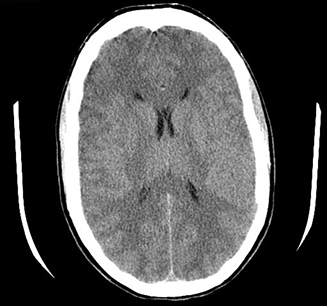Complications
If hypernatraemia is corrected too quickly in the setting of chronic hypernatraemia, the lowering of the serum osmolality can lead to water movement into the brain cells causing brain oedema.
CT scan of the brain shows diffuse sulcal effacement and slight blurring of grey-white differentiation consistent with global cerebral oedema.[Figure caption and citation for the preceding image starts]: CT brain showing diffuse sulcal effacement and slight blurring of grey-white differentiation consistent with global cerebral oedema. There is no evidence of herniationDr Hari Trivedi, Department of Radiology, San Francisco General Hospital, University of California; used with permission. [Citation ends].
May develop due to rapid administration of dextrose-containing fluids.
More likely to occur in patients with diabetes, those with physiological stress, or when high infusion rates are used.
Patients should be monitored for the development of hyperglycaemia and associated dextrose-induced osmotic diuresis, which can worsen the hypernatraemia.
If hypernatraemia is worsened by the patient’s inability to metabolise the glucose load, a less concentrated solution of dextrose (e.g., dextrose 2.5% in water), or even pure water, may be given.
Myelinolysis (also known as osmotic demyelination syndrome) has been described rarely in patients with hypernatraemia (it is more common in patients with rapid correction of hyponatraemia).[66][117][118][119]
Hypernatraemia-induced osmotic demyelination can lead to permanent neurological dysfunction.[118]
Brain MRI shows a symmetric central pontine lesion with trident shape and areas of restricted diffusion.[Figure caption and citation for the preceding image starts]: Brain MRI showing a symmetric central pontine lesion (arrows), sparing the peripheral fibres, with a typical trident shape and areas of restricted diffusion. Suggests osmotic demyelination syndrome. Note the symmetric thalamic lesions (open arrows) in images B and CBMJ Case Reports 2012, doi: 10.1136/bcr:11.2011.5198 [Citation ends].
Use of this content is subject to our disclaimer